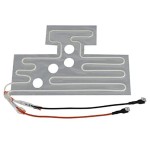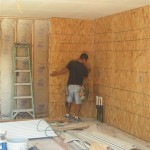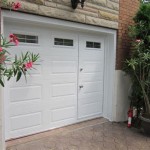```html
How To Install Outdoor Garage Lights
Adequate outdoor garage lighting is crucial for safety, security, and convenience. Properly illuminated areas around a garage enhance visibility, deter criminal activity, and facilitate tasks such as parking, unloading groceries, and accessing tools or equipment. This article provides a comprehensive guide on how to install outdoor garage lights, covering essential preparations, wiring considerations, and step-by-step installation procedures.
Planning and Preparation
Before commencing any electrical work, careful planning is paramount. This involves assessing lighting needs, selecting appropriate fixtures, and gathering necessary tools and materials. A well-thought-out plan ensures a safe and efficient installation process.
1. Assessing Lighting Needs: The first step is to determine the specific lighting requirements for the garage exterior. Consider the size of the area to be illuminated, the desired light intensity, and any specific areas that require focused lighting, such as the driveway or entrance. Different lighting fixtures offer varying levels of brightness and coverage. For example, floodlights provide wide-area illumination, while spotlights offer focused beams. Motion-activated lights are beneficial for security purposes, automatically illuminating the area when movement is detected.
2. Selecting Appropriate Fixtures: The selection of lighting fixtures should be based on both functional and aesthetic considerations. Factors to consider include the type of light (e.g., LED, halogen, incandescent), the fixture's design, and its weather resistance. LED lights are generally preferred due to their energy efficiency, long lifespan, and low maintenance requirements. The fixture's design should complement the architectural style of the house. Weather resistance is crucial for outdoor fixtures, ensuring they can withstand rain, snow, and extreme temperatures. Look for fixtures with a high Ingress Protection (IP) rating, indicating their level of protection against dust and moisture.
3. Gathering Tools and Materials: Ensure all necessary tools and materials are on hand before starting the installation. Essential tools include a voltage tester, wire strippers, pliers, screwdrivers (both flathead and Phillips), drill with various drill bits, ladder, safety glasses, and work gloves. Required materials include the lighting fixture(s), electrical wire (gauge based on local electrical codes and fixture specifications), wire connectors, electrical tape, mounting hardware, and a weatherproof junction box (if replacing an existing fixture or installing a new wiring run).
4. Checking Local Codes and Regulations: Before starting any electrical work, it is imperative to check local electrical codes and regulations. These codes specify requirements for wiring, grounding, and fixture placement. Compliance with local codes is essential for safety and to avoid potential fines or penalties. If unsure about specific requirements, consulting a licensed electrician is recommended.
Wiring Considerations and Safety Precautions
Working with electricity poses inherent risks. Adhering to strict safety precautions and understanding basic wiring principles is critical to prevent electrical shock and ensure a safe installation.
1. Turning Off the Power: The most crucial safety precaution is to turn off the power to the circuit at the circuit breaker. Verify that the power is off using a voltage tester before touching any wires. Test both the hot (usually black or red) and neutral (usually white) wires to ensure no voltage is present. Even with the power off, treat all wires as if they are live.
2. Understanding Wiring Basics: Familiarize with basic wiring concepts, including identifying hot, neutral, and ground wires. The hot wire carries electricity from the breaker to the fixture, the neutral wire returns electricity to the breaker, and the ground wire provides a path for stray current in case of a fault. Ensure proper connections between these wires to ensure the fixture functions correctly and safely. Incorrect wiring can cause short circuits, electrical fires, or damage to the fixture.
3. Choosing the Right Wire Gauge: The gauge of the electrical wire is determined by the amperage rating of the circuit and the distance the wire needs to run. Using a wire gauge that is too small can cause the wire to overheat and potentially start a fire. Consult local electrical codes or a licensed electrician to determine the appropriate wire gauge for the specific lighting fixture and circuit.
4. Using Weatherproof Connections: Outdoor electrical connections must be weatherproof to prevent moisture from entering the wiring and causing corrosion or short circuits. Use weatherproof wire connectors, such as silicone-filled wire nuts, and ensure the junction box is properly sealed. Apply electrical tape over the wire connectors for added protection. Consider using conduit to protect exposed wiring from the elements.
Step-by-Step Installation Procedure
The following provides a detailed guide on installing outdoor garage lights. Specific steps may vary depending on the type of fixture being installed and the existing wiring configuration.
1. Removing the Existing Fixture (If Applicable): If replacing an existing fixture, carefully remove the old fixture. Turn off the power to the circuit breaker. Unscrew the fixture from the junction box and disconnect the wires using wire strippers or pliers. Cap the wires with wire connectors for safety until the new fixture is ready to be installed. Inspect the junction box for any damage and replace it if necessary.
2. Preparing the Wiring: If installing a new wiring run, carefully plan the route of the wiring. Run the electrical wire from the circuit breaker to the location of the new fixture, using appropriate conduit or cable staples to secure the wiring. Ensure the wiring complies with local electrical codes. If tapping into an existing circuit, use a junction box to make the connections. Strip approximately ½ inch of insulation from the ends of the wires to expose the copper conductors.
3. Mounting the Fixture: Attach the mounting bracket to the junction box using the screws provided. Ensure the bracket is securely attached and level. Carefully lift the new fixture and align it with the mounting bracket. Connect the wires from the fixture to the wires in the junction box using wire connectors. Typically, the black wire from the fixture connects to the black (hot) wire in the junction box, the white wire from the fixture connects to the white (neutral) wire, and the green or bare copper wire from the fixture connects to the green or bare copper (ground) wire.
4. Connecting the Wires: Securely twist the wires together with wire connectors, ensuring a tight and reliable connection. Wrap electrical tape around the wire connectors for added insulation and protection. Carefully tuck the wires into the junction box, ensuring they are not pinched or stressed. Position the fixture over the mounting bracket and secure it with the screws provided.
5. Testing the Installation: After installing the fixture, turn on the power at the circuit breaker. Test the fixture to ensure it is working properly. If the fixture does not turn on, check the wiring connections and the circuit breaker. If the fixture flickers or exhibits other issues, turn off the power and re-examine the wiring connections.
6. Sealing the Fixture: To prevent moisture from entering the fixture, apply a bead of weatherproof sealant around the perimeter of the fixture where it meets the wall. This will help to create a watertight seal and protect the electrical components from the elements. Inspect the fixture periodically for any signs of damage or wear.
7. Installing Motion Sensors (If Applicable): If the fixture includes a motion sensor, follow the manufacturer's instructions to adjust the sensitivity and range of the sensor. This will help to prevent false alarms and ensure the sensor is accurately detecting movement. Test the motion sensor to ensure it is working properly.
8. Grounding the Fixture: Grounding is a critical safety measure. The ground wire provides a safe path for electrical current in case of a fault, preventing electrical shock. Connect the ground wire from the fixture to the ground wire in the junction box. If the junction box is metal, ensure it is properly grounded by connecting the ground wire to the grounding screw inside the box.
9. Securing Wires and Cables: Secure all wires and cables to prevent them from dangling or rubbing against sharp edges. Use cable staples or clamps to secure the wiring to the wall or ceiling. This will help to prevent damage to the wiring and reduce the risk of electrical hazards.
By following these steps and adhering to all safety precautions, individuals can successfully install outdoor garage lights, enhancing the safety, security, and convenience of their property. If uncertainty arises during any stage of the installation process, consulting a qualified electrician is strongly advised.
```
How To Install Outdoor Garage Lights Over The Moon

How To Install And Wire Outdoor Light Fixtures Easy Home Diy Project Youtube

Comprehensive Guide To Garage Exterior Lighting Adding Curb Appeal

Diy Install New Outside Driveway Lights Garage Wall Lanterns Youtube

Diy Install New Outside Driveway Lights Garage Wall Lanterns Youtube

How To Choose The Best Garage Lighting For Your Home

How To Install An Ultra Thin Led Downlight Outdoors 1000bulbs Youtube

How To Install Outdoor Floodlights True Value

Outdoor Lighting Guide Delmarfans Com

How To Install A Led Porch Light Outdoor For Warmer Welcome








